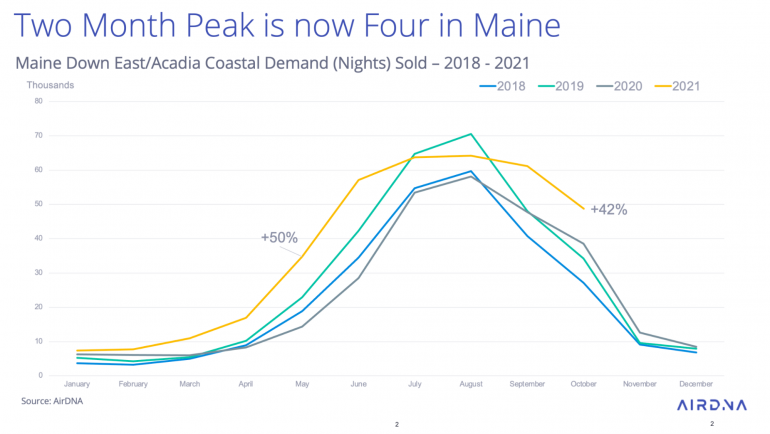Travel Is Back, in Case You Missed It
The pandemic has changed the way we travel, but the industry is bouncing back.

Many or all of the products on this page are from partners who compensate us when you click to or take an action on their website, but this does not influence our evaluations or ratings. Our opinions are our own.
Many people are curious when travel will come back. This is a difficult question to answer, because in many ways it already has — travel is nearly back to pre-pandemic levels and has been for months.
The number of passengers who entered Transportation Security Administration checkpoints in January and February of 2022 was down only 19% from the same period in 2019. That's a big recovery from the pandemic lows, when the number of passengers was down 89% in the second quarter of 2020 relative to the same period in 2019.
A closer look at the numbers
In fact, passenger numbers edged closer and closer toward pre-pandemic levels each quarter in 2021, despite the delta and omicron variants' surges.
This is especially surprising given that business travel, which usually accounts for a large portion of air traffic volume, has been slow to recover. According to a February poll by the Global Business Travel Association, corporate travel buyers estimate that they are only making 33% of bookings compared to pre-pandemic levels.
So planes are full, despite business travelers staying home. Which means that leisure travel isn’t just picking back up. It is already way up.
And yet, “returning to pre-pandemic levels” whitewashes the complexity of how the travel industry has changed.
» Learn more: The best travel credit cards right now
Remote work has changed the game
Business travel may remain slow, but a new kind of traveler has helped fill the gap: remote workers. Working from anywhere means leisure travel is no longer limited to vacation for these so-called “laptop luggers.” Some have even become full-time digital nomads, traveling from one location to the next without a permanent home.
According to a survey by Deloitte, workers who could bring their jobs with them planned twice as many holiday trips as those who planned to disconnect from work. This suggests a fundamental shift in the way remote work has enabled more frequent travel.
And it’s not just how often, but when these travelers are choosing to leave home. Rather than cramming vacations into a few months in the summer and a few weeks in the winter, untethered travelers are now expanding the “shoulder seasons” in the spring and fall, when leisure travel usually dips.
A report from AirDNA, which tracks vacation rental data, suggests that peak travel seasons have become flatter and broader in some destinations. For example, vacation rental bookings along the Maine coast, which includes Acadia National Park, were up 50% in May and 42% in October of 2021. However, demand was actually down slightly during summer months compared to 2019.

AirDNA data shows a shift in seasonal vacation rental trends. (Graph courtesy of AirDNA)
In many ways, this is good for everyone. Tourist and accommodation businesses will enjoy longer seasons, and vacationers won’t be competing with each other so feverishly during a few peak months.
It’s also good news for airlines, which will shuttle far more passengers over a longer travel window than they can over a short period of peak demand.
Consider Thanksgiving, which usually taps out the limited supply of aircraft in the few days that workers are able to get off work and travel. Remote workers can book longer trips that avoid peak dates, saving money and flattening the peak, while airlines can move more passengers overall.
International travel has been slower to recover
Peeling the “travel is back” onion back one more layer, we can see that it’s more complicated for international travel. Although domestic leisure travel has bounced back, border and testing restrictions have slowed the pace for U.S. travelers heading overseas.
According to data from the International Trade Administration, 2.5 million U.S. citizens departed the country in January 2022 compared to nearly 4 million in 2019. This is far more than the 1 million who departed in 2021, but still a far cry from full recovery.
If you go back another layer, the picture becomes even more interesting. Travel by U.S. citizens to Mexico actually exceeded 2019 levels, while Australia — which only recently opened its borders — saw only 11% as many U.S. visitors in January 2022 compared to 2019. Travel to Europe in January 2022 stood at only 44% of pre-pandemic levels.
On the flip side, only 44% as many overseas travelers came to the U.S. in January. So businesses that depend on foreign tourists remain hard hit by the pandemic, even as domestic travel rebounds.
» Learn more: How to save money on international flights
Travel is back — it just looks different
If you live in a major U.S. city that followed lockdown restrictions rigorously for the past two years, you might be surprised to learn how much the travel industry has already rebounded.
It’s worth reconsidering some basic ideas of what travel coming "back" really means. In terms of raw numbers, nearly as many travelers are passing through airports now as they were in 2019. But the pattern and distribution of these travelers has fundamentally changed.
Remote work has loosened the restrictions on how and when many people travel. This means longer seasons, fewer peaks and possibly more travelers overall. That said, most of this travel remains domestic, and the number of foreign tourists visiting the U.S. is far from “back.”
How to maximize your rewards
You want a travel credit card that prioritizes what’s important to you. Here are some of the best travel credit cards of 2024:
Flexibility, point transfers and a large bonus: Chase Sapphire Preferred® Card
No annual fee: Wells Fargo Autograph® Card
Flat-rate travel rewards: Capital One Venture Rewards Credit Card
Bonus travel rewards and high-end perks: Chase Sapphire Reserve®
Luxury perks: The Platinum Card® from American Express
Business travelers: Ink Business Preferred® Credit Card
Chase Sapphire Preferred® Card
Travel
Dining
🔥 Huge highest-ever bonus on NerdWallet's 2025 Best All-Purpose Travel Rewards Card is back. Don't miss your rare chance to: Earn 100,000 points when you spend $5,000 on purchases in the first three months. That's worth at least $1,250 toward travel booked through Chase.


